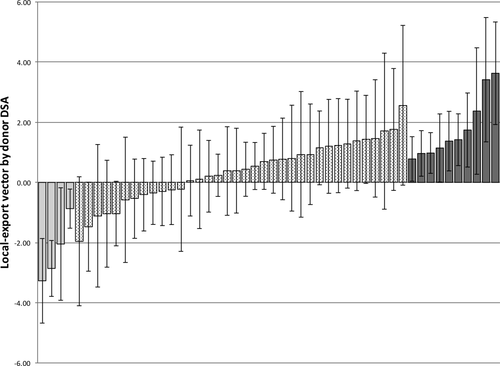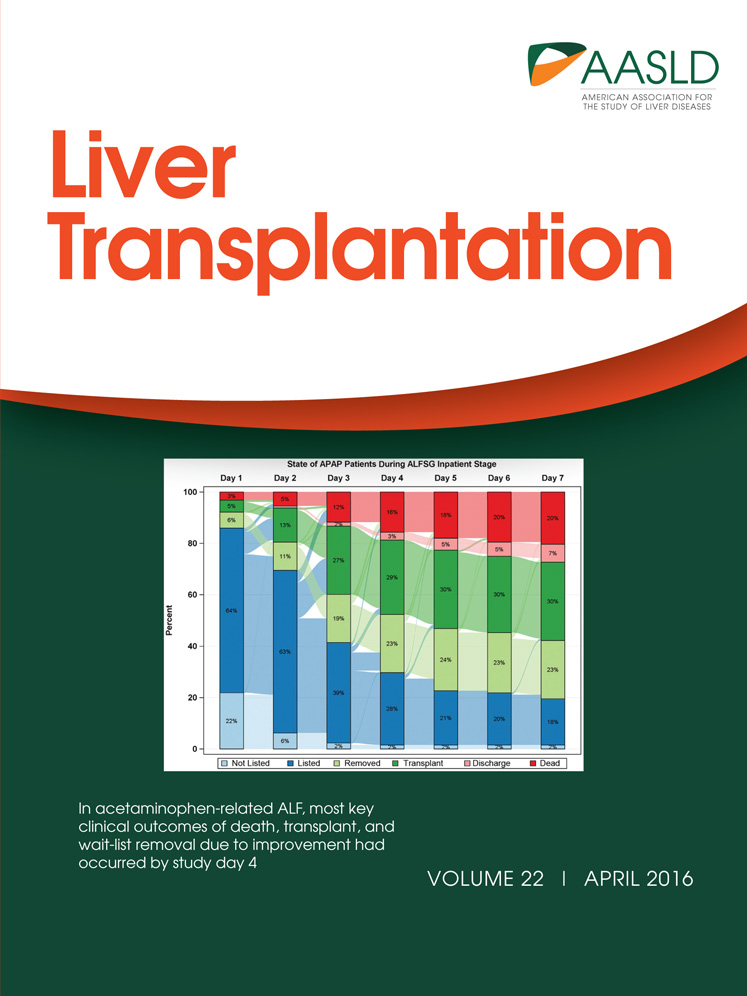Socioeconomic gradients between locally transplanted and exported liver donors and recipients
The data reported here have been supplied by the Minneapolis Medical Research Foundation as the contractor for the Scientific Registry of Transplant Recipients (SRTR). The interpretation and reporting of these data are the responsibility of the authors and in no way should be seen as an official policy of or interpretation by the SRTR or the US Government.
This study was presented at the American Transplant Congress, Philadelphia, PA, May 2–6, 2015.
Joel T. Adler is funded by the Arthur Tracy Cabot fellowship from the Center for Surgery and Public Health at Brigham and Women's Hospital.
Potential conflict of interest: Nothing to report.
To undergo more timely transplantation, patients of higher socioeconomic status (SES) are able to travel to donor service areas (DSAs) with shorter wait lists and lower Model for End-Stage Liver Disease (MELD) scores at transplant requirements.1, 2 This contributes to distrust in the organ allocation system among lower SES populations and a reluctance to donate.3-5 Because of geographic variation in SES, transplanting livers outside the donor's DSA could also exacerbate SES disparities in liver transplantation.6 With ongoing discussions of broader sharing,7 we looked at differences in SES between donors and recipients of locally transplanted and exported livers.
The SES index from the Agency for Healthcare Research and Quality,8 based on 2010 ZIP code US Census data,9, 10 was used to estimate the SES for adult-isolated deceased donor liver transplantation donors and recipients between 2007 and 2012. Two recipient-donor SES gradients (SESrecipient – SESdonor) were determined for each DSA: one for locally transplanted livers and another for exported livers. These were used to calculate the local-export vector (Gradientexported – Gradientlocal), such that a positive value represents a DSA in which exported livers go to recipients of a higher SES index than locally transplanted livers. We tested whether DSA local-export vectors were associated with the proportion of livers exported and MELD score at transplant.
Among 27,970 donors and recipients, the mean SES indices were 50.4 ± 4.2 for donors, 51.2 ± 4.3 for locally transplanted livers, and 51.0 ± 4.4 for exported livers. Thirty-six of the 50 DSA local-export vectors had no net direction (Fig. 1), and there were 4 DSAs with statistically negative local-export gradients and 10 DSAs with positive local-export gradients. There was no association between the percentage of livers exported from the DSA and the local-export vector for that DSA (P = 0.76). Because high organ availability DSAs with low mean MELD scores at transplant export livers more frequently,11 we assessed the relationship between mean MELD score at transplant and the local-export gradient and found none (P = 0.46).

Local-export vectors that were statistically significantly different from 0 are indicated by light gray, where the exported livers had a more downward donor-recipient gradient, and dark gray, where the exported livers had a more upward donor-recipient SES index difference. Error bars indicate the 95% confidence interval.
Contrary to conventional wisdom, we found little evidence that exporting livers promoted more SES disparity than transplanting livers locally. Overall, these disparities do not appear to be the result of, or to be exacerbated by, the exportation of livers to recipients outside the donor DSA. However, there are a handful of DSAs where exports do go to higher SES recipients than local recipients (and vice versa). As redistricting proposals are considered, it will be important to consider the effect of redistribution proposals on individual DSAs because these may not be apparent when examining national statistics in aggregate.
-
Joel T. Adler, M.D., M.P.H.1
-
Joseph A. Hyder, M.D., Ph.D.2
-
James F. Markmann, M.D., Ph.D.1
-
David A. Axelrod, M.D., M.B.A.1,3
-
Heidi Yeh, M.D.1
-
1Division of Transplant Surgery
-
Massachusetts General Hospital
-
Boston, MA
-
2Department of Anesthesiology
-
Mayo Clinic
-
Rochester, MN
-
3Section of Transplant Surgery
-
Dartmouth Hitchcock Medical Center
-
Lebanon, NH




